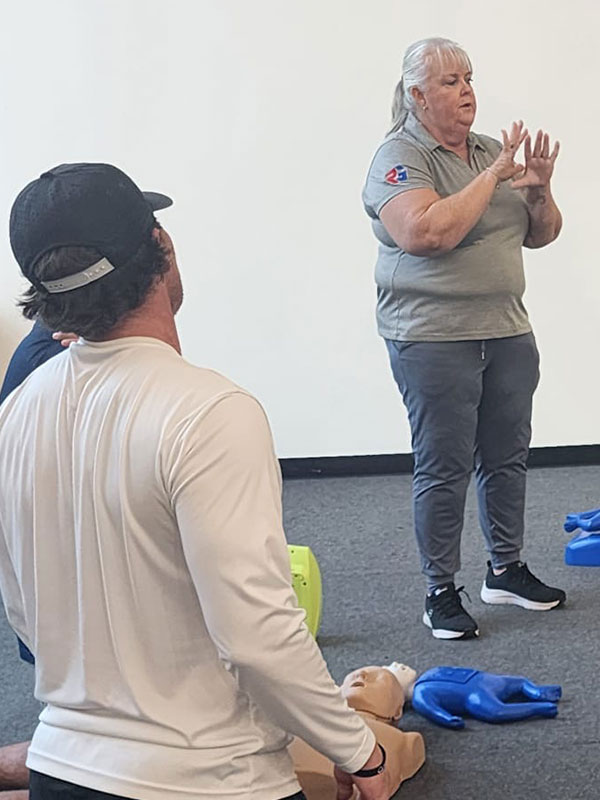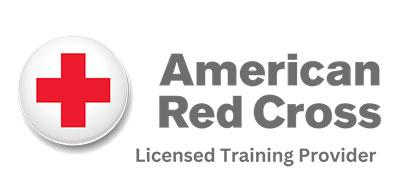




Book a custom class online OR call us at 866-277-2337
The American Heart Association Heartsaver for K-12 First Aid CPR AED is a classroom, video-based, instructor-led course that will teach students the critical skills needed to respond to and manage a first aid, choking, or sudden cardiac arrest emergency in the first few minutes of an emergency until medical services help (EMS) arrives. Students will learn skills such as how to treat bleeding, sprains, broken bones, shock, and other first aid emergencies. This course also teaches adult and child (1+) CPR and AED use.
The Heartsaver for K-12 Schools eCard may be provided by AHA Training Center Coordinators to K-12 school students, faculty, and staff who successfully complete an AHA Heartsaver First Aid CPR AED, Heartsaver CPR AED, or Heartsaver First Aid Course. “Faculty” refers to teachers and coaches; “staff” refers to an employee of a K-12 school or K-12 school system.
This will close in 0 seconds
The American Heart Association Heartsaver for K-12 First Aid CPR AED is a classroom, video-based, instructor-led course that will teach students the critical skills needed to respond to and manage a first aid, choking, or sudden cardiac arrest emergency in the first few minutes of an emergency until medical services help (EMS) arrives. Students will learn skills such as how to treat bleeding, sprains, broken bones, shock, and other first aid emergencies. This course also teaches adult and child (1+) CPR and AED use.
The Heartsaver for K-12 Schools eCard may be provided by AHA Training Center Coordinators to K-12 school students, faculty, and staff who successfully complete an AHA Heartsaver First Aid CPR AED, Heartsaver CPR AED, or Heartsaver First Aid Course. “Faculty” refers to teachers and coaches; “staff” refers to an employee of a K-12 school or K-12 school system.
** All courses offered thru regular traditional classroom type classes or blended Online and In-person
This will close in 0 seconds
The Heartsaver CPR AED course trains participants to give CPR and use an automated external defibrillator (AED) in a safe, timely, and effective manner. This program reflects science and education from the American Heart Association Guidelines Update for CPR and Emergency Cardiovascular Care (ECC).
The AHA Heartsaver CPR AED Course is designed for anyone with limited or no medical training who needs a course completion card in CPR and AED use to meet job, regulatory, or other requirements.
*Child and infant modules are optional.
** All courses offered thru regular traditional classroom type classes or blended Online and In-person
This will close in 0 seconds
The AHA’s Heartsaver First Aid CPR AED course trains participants to provide first aid, CPR, and use an automated external defibrillator (AED) in a safe, timely, and effective manner. This program reflects science and education from the American Heart Association Guidelines Update for CPR and Emergency Cardiovascular Care (ECC).
The AHA’s Heartsaver First Aid CPR AED Course is designed for anyone with little or no medical training who needs a course completion card for their job, regulatory (e.g., OSHA), or other requirements, or anyone who wants to be prepared for an emergency in any setting.
This will close in 0 seconds
The steps are simple – get started today!
The American Heart Association is always seeking professionals to conduct training in first aid, CPR, AED, and advanced cardiovascular care. If you are passionate about saving lives, motivated to facilitate learning, feel comfortable in group settings, and find it easy to make complex concepts understandable to others, you may be a perfect candidate.
Becoming an American Heart Association instructor is easy when you choose Miami First Aid to assist you with your training.
Contact us for additional information.
As a licensed Training Provider for the American Red Cross, your journey to a new career as a CPR/AED, First Aid Instructor starts now. We will guide you through every step of the way — from helping you achieve your goal of becoming an educator to supporting your entrepreneurial dreams of being your own boss. The experts at Miami First Aid have you covered.
This course will train instructor candidates to teach basic-level American Red Cross First Aid CPR and AED courses. In order to participate in this course you must:
Upon registration it is important that you review and follow the directions on the e-mail attachment sent with your registration confirmation. This is a blended learning course consisting of online content a skills session and classroom segments. Online material must be completed prior to attending the classroom activities. For more information please reference the attachment you will receive via e-mail when you register for this course.
This will close in 0 seconds
The AHA’s BLS course trains participants to promptly recognize several life-threatening emergencies, give high-quality chest compressions, deliver appropriate ventilations, and provide early use of an AED. This program reflects science and education from the American Heart Association Guidelines Update for CPR and Emergency Cardiovascular Care (ECC).
The AHA’s BLS Course is designed for healthcare professionals and other personnel who need to know how to perform CPR and other basic cardiovascular life support skills in a wide variety of in-facility and prehospital settings.
This will close in 0 seconds
For healthcare providers who respond to emergencies in infants and children and for personnel in emergency response, emergency medicine, intensive care, and critical care units.
The PALS Provider Course aims to improve outcomes for pediatric patients by preparing healthcare providers to effectively recognize and intervene in patients with respiratory emergencies, shock, and cardiopulmonary arrest by using high‐performance team dynamics and high‐quality individual skills.
The course includes a series of case scenario practices with simulations that reinforce important concepts. Upon successful completion of all the patient cases, students must pass the multiple-choice exam with a minimum score of 84%.
This will close in 0 seconds
The AHA’s ACLS course builds on the foundation of lifesaving BLS skills, emphasizing the importance of continuous, high-quality CPR. This program reflects science and education from the American Heart Association Guidelines Update for CPR and Emergency Cardiovascular Care (ECC).
For healthcare professionals who either direct or participate in the management of cardiopulmonary arrest or other cardiovascular emergencies, and for personnel in emergency response.
** All courses offered thru regular traditional classroom type classes or blended Online and In-person
This will close in 0 seconds